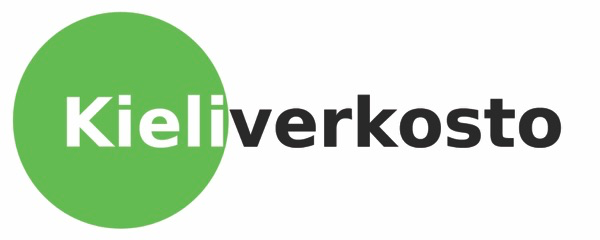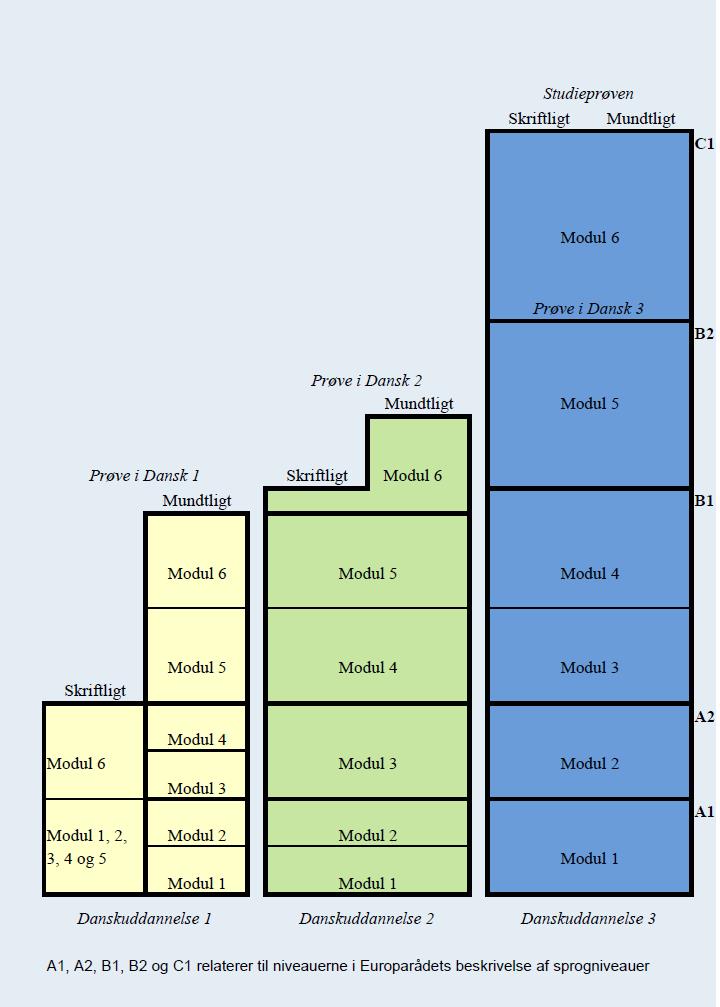Education in Danish
Teaching of Danish is today divided into three different tracks or educational programs, which are called Danskuddannelse 1, Danskuddannelse 2 and Danskuddannelse 3 (see Figure 1). Each of them includes 6 modules. Danskuddannelse 1 is intended for the illiterate or for candidates who have learnt to read by means of a non-Latin alphabet. Danskuddannelse 2 is for candidates with a short educational background, who can read and write the Latin alphabet, and Danskuddannelse 3, for candidates who have an extensive educational background, e.g. university studies in their home country. A characteristic feature of the L2 Danish language education for adult migrants is that both the language education and the final exams are organised in a way that takes the persons’ educational background into account. This means that the final exams are also designed to test real-life communication beyond the test. Migrants have the right to free Danish language education from 3 to 5 years depending on what legal basis the migrant is staying in the country.
Figure 1. The three different tracks in teaching Danish
There are today more participants than ever before undertaking Danish language education. Between 2004 and 2015, the number of people taking Danish courses has risen by 37%. This is due to the large amount of labour migration, and also due to the fact that there has at the same time been a significant rise in the number of migrants coming from Syria. In 2015, approximately 52,500 persons participated in the three different study programs of Danish, and 17% of them were placed in Danskuddannelse 1, 49% in Danskuddannelse 2, and 34% in Danskuddannelse 3.
Tests and test levels
There are four centralised final exams in Denmark. They are general language tests, that is: Prøve i Dansk 1, Prøve i Dansk 2, and lastly Prøve i Dansk 3, which finalises the three educational programs’ long study program in Danish. In addition, there is a test called Studieprøven, which is one level higher than Prøve i Dansk 3 and which has the special aim of assessing if a candidate has sufficient skills in Danish to be able to study at university in Denmark.
Both the aims of the language education and the final language exams are linked to the Common European Framework for Languages (CEFR). The four tests in Danish include both a written and an oral component and have the same target to assess migrants’ language competence in relation to the different CEFR-levels:
| Test in Danish | Level in writing | Level in speaking |
| Studieprøven | C1 | C1 |
| Prøve i Dansk 3 | B2 | B2 |
| Prøve i Dansk 2 | B1 | B1+ |
| Prøve i Dansk 1 | A2 | B1 |
A migrant who is at least 18 years old has the right to take the exam even if they have not participated in formal Danish language education. About 11,000 candidates took the exam in 2015, approximately a 7% increase in the amount of test takers compared with the year before.
Tests in Danish and the question of rights
Since 2003, some of the Danish tests have been connected with the attainment of certain rights, and in the past few years, the various ruling governments have differed in their opinions of which tests should be connected with which rights. Today, Prøve i Dansk 2 is connected to obtaining permanent residency in Denmark. Prøve i Dansk 3 is connected to Danish citizenship. If a person fulfils a number of other requirements, e.g. having been employed for a certain number of years, passing Prøve i Dansk 2 may be sufficient for them to obtain Danish citizenship. In addition to the language test, the person is, however, required to take tests in Danish history, culture, and society. These knowledge tests are also used in connection with obtaining the right to permanent residence.
When language tests are combined with personal rights, the quality requirements of the tests have to be very high. ALTE (Association of Language Testers in Europe) is an important structure in supporting the continuous development of language tests with the goal of attaining higher quality. In connection with this, the Nordic cooperation in ALTE Nordic is especially important for test development in Denmark.
Current situation and future
For the moment, the focus in Denmark is on quickly employing and integrating the large number of new migrants with a view to these new arrivals becoming self-sufficient. To this end, there has been much discussion about how language education can be made more vocationally oriented so that it can, in the best possible way, support the new citizens’ real needs in navigating the Danish labour market. This also raises questions of whether the vocational focus should be even more visible in the Danish tests. Consequently, Nordic cooperation can be an important resource when trying to find new ways to organise both the language education and the language tests.
For many years, there has been a push to digitalise the tests in Danish. Currently, there are discussions about the new possibilities that digital tests and the use of an item bank would allow for. In 2016, preparatory work for digitalising the tests of Danish was started and it will be exciting to see if this work will result in a political decision to digitalise the test of Danish.
Gitte Østergaard Nielsen, former Head of Danish Language Test Administration, The Ministry for Foreigners and Integration.
Cecilie Løsecke Olsen, present Head of Danish Language Test Administration, The Ministry for Foreigners and Integration.



